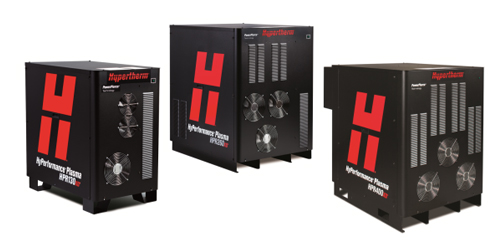

Plasma cutting is a process that is used to cut steel and other metals of different thicknesses (or sometimes other materials) using a plasma torch. In this process an inert gas (in some units, compressed air) is blown at high speed out of a nozzle at the same time an electrical arc is formed through that gas from the nozzle to the surface being cut, turning some of that gas to plasma. The plasma is sufficiently hot to melt the metal being cut and moves sufficiently fast to blow molten metal away from the cut.
Plasma is the fourth state of matter along with solids, liquids and gases. Plasma is a jet or beam of ionized gas capable of conducting electricity. This ionized jet or beam produces extreme heat of around 22,000oC.
High Definition Plasma is the same process as plasma cutting but the plasma beam is delivered through a much smaller nozzle orifice at higher velocity and results in more accurate profile cutting. A shield gas is also used to swirl around the plasma beam to constrict the beam and keep the cutting beam straight resulting in a square edge on the cut parts and better cut surface quality.
Such a CNC should be similar to the ones controlling Laser Cutting processes. A modern CNC should have Response time less than 0.5 m/sec servo loop because it must be in a position to respond faster than the cutting process it controls. It should also have linear control over the current of the Source for it to be adjustable to the Feed Rate recommended.
The cutting energy is controlled by being delivered in high-and-low-current pulses, enabling the reduction of the volume of metal melted. This way we avoid risking molten metal spattering over the nozzle and sensors and destroying them. Pulse piercing is an important tell-tale trial for CNC suitability for High Definition Plasma cutting.
Plasma Cutters are able to cut many conductive materials including Mild Steel, Aluminum, Copper and Stainless Steel. The most popular material cut in the industry is mild steel which also gives the best cutting results.
Cut quality depends to a high degree on the distance between the torch tip (nozzle) and the surface of the sheet we work on. The Plasma Arc is not cylindrical, it gets narrower in its upper and lower edges consequently, when we cut too high the cut is performed by its lower edge and vice versa. In both cases the "sides" of the cut are not square.
Please see our photo to the right: the torch is too high and the cut is "conical". It is only when the cut is performed by the middle section of the Arc that we achieve optimal cuts. Here the presence of a digital Arc Control system interconnected to the CNC is absolutely important. It must be able to interact with the CNC for the ideal Torch Height to be maintained regardless the torch velocity changes and eventual holes in the job.
A Plasma cutting machine is capable of cutting material much faster than oxy fuel but plasma is only capable of piercing material up to 50mm thick. Plasma is also able to cut a larger range of material and transfers much less heat into material than oxy fuel. Often plasma cutting torches and oxy fuel cutting torches are mounted on the same CNC cutting machine to give the machine a larger range of processing thicknesses, for example 3mm - 150+mm. For most work Plasma is more efficient than Oxy fuel as 90% of steel cut is less than 50mm thick and if you were to compare some suitable Plasma Cutting system to an oxy fuel system it would process 50mm mild steel more than twice as fast.
2D profile cutting industry makes good use of both cutting disciplines and both excel in different jobs. Lasers are best for thin gauge material whereas plasma cutters are best at cutting thicker sheets. As Laser resonators are getting more and more powerful and High Definition plasma systems cutting gets better and better there is now a large cross over between the two. The best way to see which technology is right for your company is to talk with an expert in both fields about the thickness of material needing to be cut, the amount of work needing to be processed the finish and accuracy needed and the rough budget for the machine.
Plasma Cutters are able to cut many conductive materials including Mild Steel, Aluminium, Copper and Stainless Steel. The most popular material cut in the industry is mild steel which also gives the best cutting results.
Series machine delivers productivity. HYD CNC, FLCNC, Hyper-therm control provides precision motion control for both high-speed plasma and Oxy-fuel cutting. Original Micro EDGE TM control system produced by Hypertherm, USA. Micro EDGE TM CNC system is the most advanced one developed by Hypertherm Corporation, USA on the basis of windows interface for plasma, flame, laser and high-pressure water cutter the interface design cutting speed and motion control of this system adopt the newest technology. It features powerful function and convenient operation. It is the most intellectualized system in cutting process. Arc-off time between parts is extremely short with a rapid traverse speed. Torch height control rapidly sets pierce height and maintains precise torch to plate distance while cutting-no matter what the travel speed.